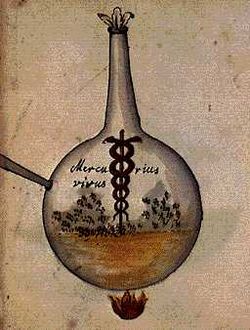Mercury process

Source: Cabala Mineralis
The mercury process is one of the three basic processes of the alchemical Tria Principia. Mercury is one of the seven planetary metals; the planet Mercury is assigned to it. The Mercurius of the alchemists stands for everything metallic, fusible, liquid; the common alchemical symbol for it is the lily. Mercurius is the volatile-liquid principle that mediates between the fiery sulphur and the form-giving salt process. The water element works in it and it is also called the bridging water of life (Latin: aqua viva pontica) or mercurial water. The material representatives in which the Mercury process has come to rest externally are above all mercury, water and alcohol. On a purely physical level, the mercurial process corresponds to the metallic bond known from chemistry[1].
Literature
- Rudolf Steiner: Das Miterleben des Jahreslaufes in vier kosmischen Imaginationen, GA 229 (1999), ISBN 3-7274-2290-4 English: rsarchive.org German: pdf pdf(2) html mobi epub archive.org
- Rudolf Steiner: Die vierte Dimension, GA 324a (1995), ISBN 3-7274-3245-4 English: rsarchive.org German: pdf pdf(2) html mobi epub archive.org
 |
References to the work of Rudolf Steiner follow Rudolf Steiner's Collected Works (CW or GA), Rudolf Steiner Verlag, Dornach/Switzerland, unless otherwise stated.
Email: verlag@steinerverlag.com URL: www.steinerverlag.com. Index to the Complete Works of Rudolf Steiner - Aelzina Books A complete list by Volume Number and a full list of known English translations you may also find at Rudolf Steiner's Collected Works Rudolf Steiner Archive - The largest online collection of Rudolf Steiner's books, lectures and articles in English. Rudolf Steiner Audio - Recorded and Read by Dale Brunsvold steinerbooks.org - Anthroposophic Press Inc. (USA) Rudolf Steiner Handbook - Christian Karl's proven standard work for orientation in Rudolf Steiner's Collected Works for free download as PDF. |
References
- ↑ V. Gutmann, E. Hengge: Allgemeine und anorganische Chemie, Verlag Chemie, Weinheim 1975, p. 3
